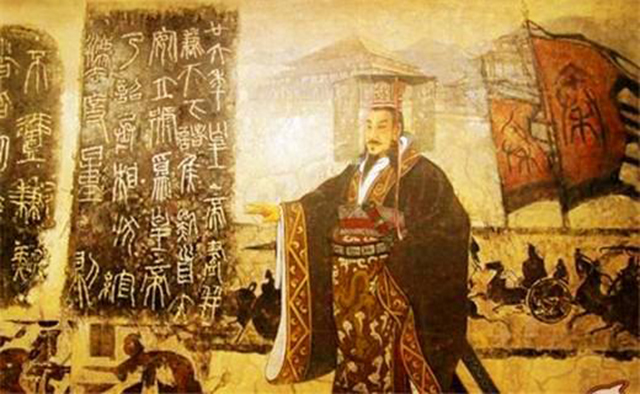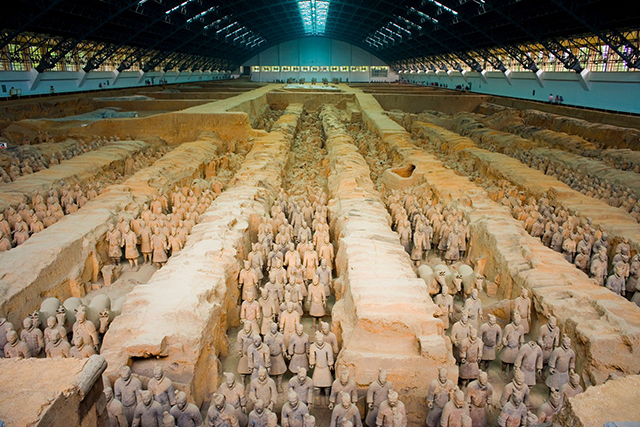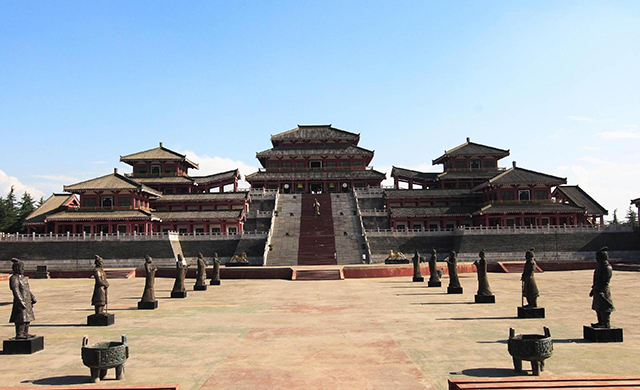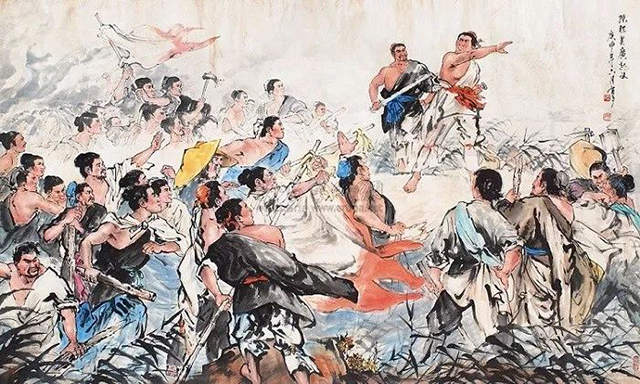The Qin Dynasty (221BC – 207BC) was the first great unified dynasty in Chinese history developed by the Qin State during the Warring States Period. In 221BC, Ying Zheng called the emperor, and the history was called “Qin Shi Huang”.
The Qin dynasty set up three public and nine princes in the central government to manage national affairs; the local abolition of the sub-sealing system and the substitution of the county system; the implementation of the same text, the same track, and unified weights and measures. The north of the Xiongnu, the south to the Baiyue, the Great Wall to refuse foreign enemies, chiseling the canal to pass the water system. The establishment of a centralized system has laid the basic pattern of China’s political system for more than 2,000 years and laid the foundation for the rule of China’s Great Unification dynasty.
The Qin Dynasty ended the situation of the split of the princes since the Spring and Autumn Period and the Warring States Period, and became the first multi-ethnic communicative state in the history of China. It has had a profound impact on Chinese history.
In 210BC, Qin Shihuang’s parade died of sand dunes (now northwest of Guangzong County, Hebei Province). His son Hu Hai was in place, Qin II. Although the Qin Dynasty had a great influence in history, it abused the people’s power and unified it for only ten years.
In 209BC, Chen Sheng and Wu Guangmu were soldiers, and they rose up. The world responded. Liu Bang and Xiang Yu started to fight against the Qin. In 207BC, Qin died.
The establishment of the Qin Dynasty
- The Qin Dynasty was a unified dynasty developed by the Qin State in the late Warring States Period. It was the first unified multi-ethnic centralized empire in Chinese history. Qin Shihuang completed the unification of the six vassal states on the kings of the Qin dynasty in the past, and realized the transformation from the system of separation to the county system. The centralized system he established and the measures he has taken (to consolidate the unity) are used by the emperors of the future generations.
The Qin Dynasty’s tyranny of tyranny led to rapid death. The peasant uprising led by Chen Sheng and Wu Guang in the last years was the first peasant uprising in Chinese history, and the impact was extremely far-reaching. Due to the influence of the past separatist situation, the tendency of splitting reappeared in the anti-Qin period. In the ensuing battle between Chu and Han (the first 207 to the former 202) for the right to rule, Han Shengchu defeated, and the divisional situation was controlled, and the country was unified. A centralized dynasty was thus established.
The demise of the Qin Dynasty
- The Qin Dynasty was in 209 BC, Chen Sheng and Wu Guang were the soldiers, and they rose up. The world responded. Liu Bang and Xiang Yu fought together against the Qin in Jianghuai. In 207 BC, the Qin Dynasty perished.
After Chen Sheng Wu Guangqi, the Chu Wang sent Song Yi and Xiang Yu to rescue Zhao Guo, and sent Liu Bangxi into Guanzhong. Song Yi came to Anyang but could not enter.
Then Xiang Yu killed Song Yi, led the troops to cross the river, and after a fierce battle, the solution of the giant deer was pushed to the prince general. Qin will pay for 200,000 people to surrender to him
Liu Bangxuan returned to Wuguan and arrived near Xianyang. At that time, Qin II had been killed by Zhao Gao. The son of the infant, who went to the emperor, called Qin Wang and surrendered to Liu Bang. Liu Bang captured the Xianyang Qin Dynasty.
China’s First Emperor-Qin Shi Huang

Qin Shi Huang rule china for 37 years(246BC-210BC),he was 49 years old when he died.
Qin Shihuang (259 BC – 210 BC), Ying Zheng, also known as Zhao Zheng (political), Qin Zheng, or Zu Long, the son of Qinzhuang. The famous politician, strategist and reformer in Chinese history, the iron fist politician who completed the Chinese unification, and the first Chinese emperor to be the emperor. Qin Shihuang was born in Han Dan (now Han Dan) in the capital city of Zhao, and spent his youth here. In 247 BC, at the age of 13, it was the throne. In 238 BC, at the age of 22, the monarch adult coronation ceremony was held in the capital city of the capital, and the “pro-political politics” was started. The people of Lu Buwei and Yu were removed, and Li Si and Yu were reused. From 230 BC to AD In the first 221 years, the six countries of Han, Zhao, Wei, Chu, Yan and Qi were successively eliminated. At the age of 39, the great cause of reunification of China was completed, and a powerful country with centralization of the Han nationality, the Qin Dynasty, was established and laid. The territory of China.
Qin Shihuang believed that his merits were better than the previous Three Emperors and Five Emperors. He used the emperor of the Three Emperors and the Emperor of the Five Emperors to form the title of “Emperor”. He was the first monarch in Chinese history to use the title of “Emperor”, so he called himself “The First Emperor.” “. At the same time, the implementation of the three public and nine Qing in the central government, the management of national events. The local abolition of the sub-sealing system, replaced by the county system, while the same text, the same track, unified weights and measures. Foreign troops attacked the Xiongnu, Nanzheng Baiyue, built the Great Wall, built a spiritual channel, and communicated with the water system.
However, in the later period, the dream of immortality, the tyranny of government, and the killing of the people, swayed the foundation of the Qin dynasty. In 210 BC, Qin Shihuang’s east patrol crashed into the sand dunes of Xingtai.
Qin Shihuang is a legendary epoch-making figure in Chinese history. It was the founding emperor of the Qin Dynasty in the first great dynasty in Chinese history. It had a profound influence on China and the history of the world and pushed China to the era of the Great Unification. Lay the basic pattern of China’s political system for more than two thousand years, and was praised by the Ming Dynasty thinker Li Yu as “the emperor of the ages”
Get The Video of “The First Emperor Of China” on Amazon:
The Mausoleum of the First Qin Emperor

After Emperor Qin Shihuang ascended the throne, he began to build the Imperial Tomb for himself until his son succeeded. This huge emperor’s tomb was called “The Mausoleum of the First Qin Emperor“. The entire project lasted 39 years and was the first large-scale, well-designed imperial mausoleum in Chinese history. There are a large number of burial pits and tombs with different shapes and different connotations around the mausoleum. More than 400 have been discovered, including the world-famous “World’s Eighth Wonder” Terracotta Warriors.
| The Mausoleum of the First Qin Emperor Tourist Card | |||
|---|---|---|---|
| Chinese Name | 秦始皇陵 | Reputation | The eighth wonder of the world |
| English Name | Mausoleum of the First Qin Emperor | Value | The first batch of world cultural heritage |
| Geographic location | LinTong District, Xi’an City, Shaanxi Province | Opening hours | 08:30-17:30 |
| Floor area | 56.25 square kilometers | Ticket price | High season: 150 yuan Low season: 120 yuan |
| Building age | Qin Dynasty | Famous scenery | Terracotta Warriors and Li Shan |
| Mausoleum | Emperor Qin Shihuang | Recommended length of play | 2-3 hours |
| Heritage protection level | The first batch of national key cultural relics protection units | Suitable for the play season | All Seasons |
| Attraction level | The first batch of national AAAA level scenic spots | City | Xi’an City, Shaanxi Province |
Qin Shi Huang Mausoleum Museum Official Website: http://www.bmy.com.cn:8090/
Qin Dynasty Terracotta Warriors
| Terracotta Warriors are a category of ancient tomb sculptures. In ancient times, human beings were practiced. The slaves were the attachments of the slave masters. After the slave owners died, the slaves were to be buried as slaves. The terracotta warriors and horses are made into funerary objects in the shape of soldiers and horses (chariots, horses, soldiers). |
Get The Videos of “Terracotta Warriors” on Amazon:
 |
 |


